The melodic minor scale is a dynamic and multifaceted tool for any musician.
It can transform the entire mood of a piece, inject major and minor tonalities, and add endless complexity to your tracks.
As a music producer, understanding this intriguing scale is crucial for expanding your musical skills and enhancing your creative expression.
By mastering the melodic minor scale, you can play around with various emotional landscapes and create tracks that really stick with your audience.
In today’s lesson, we’ll break down:
- The unique structure of the melodic minor scale ✓
- Differences between ascending and descending forms ✓
- Comparisons with natural and harmonic minor scales ✓
- Expert applications in chord progressions ✓
- Techniques for utilizing scale degrees ✓
- Harmonic possibilities and complex chords ✓
- Exploring melodic minor modes ✓
- Pro Tips for innovative song creation ✓
- Much more ✓
After reading this article, you’ll be able to utilize the full potential of this beautifully complex scale.
You’ll be equipped to create hypnotic melodies, rich harmonies, and compelling progressions like a seasoned professional.
So, let’s dive in…
Table of Contents
- What is the Melodic Minor Scale?
- Ascending Forms vs. Descending Forms of the Melodic Minor Scale
- Pro Tip: Differences Between Major and Minor Scales (A Quick Recap)
- Understanding The Other 2 Minor Scales
- Building Chords within the Melodic Minor Scale
- Innovative Chord Progressions in Minor Keys
- The Secret To Melodic Mastery: The Unison Melodic Minor (Classical Minor) Advanced Scales MIDI Collection
- Harmony and the Melodic Minor Scale
- The Ascending Melodic Minor Scale & The Descending Melodic Minor Scale: Things To Remember
- Melodic Minor Scale Summary: Final Thoughts
What is the Melodic Minor Scale?
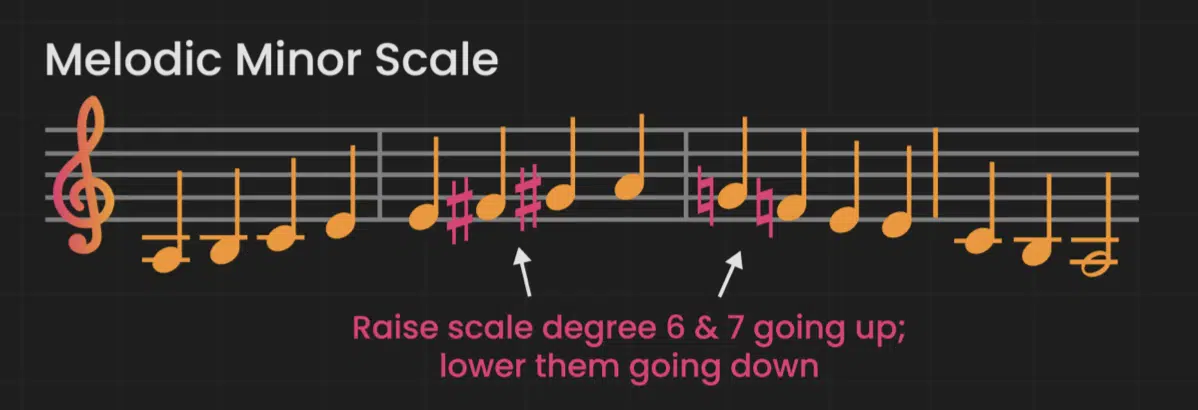
The melodic minor scale, a fundamental concept in music theory, stands out in its ability to add complex emotional textures to compositions.
This scale is particularly intriguing for its distinct behavior compared to the natural minor and harmonic minor scales.
Imagine you’re working with the A natural minor scale (containing the notes A-B-C-D-E-F-G) in a digital audio workstation…
Now, modify it to the A melodic minor scale (containing the notes A-B-C-D-E-F#-G#) on the ascent.
This slight alteration leads to a substantial shift in the tonal quality which is where the beauty lies
It opens up exciting new opportunities for musical expression.
The essence of the melodic minor scale lies in its versatility and its ability to straddle the line between minor and major tonalities.
This quality makes it an invaluable tool for digital music producers looking to create depth and variation in their music.
When ascending, the melodic minor scale adopts a major-like quality by raising the sixth and seventh degrees.
This is a sharp contrast to the more somber tone of the natural minor scale, and this duality (two forms) allows for a richer harmonic palette in your tracks.
In music production, where emotion and atmosphere are key, the melodic minor scale offers a unique combination of moods.
NOTE

The Melodic Minor Scale is formed by a combination of half steps and whole steps.
In the ascending form, it starts with a whole step, followed by one half step, and then continues with four consecutive whole steps, ending with a half step.
Specifically, this whole step/half step pattern can be represented as:
- W (whole-step)
- H (half-step)
- W (whole step)
- W (whole step)
- W (whole step)
- W (whole step)
- H (half-step)
This unique sequence of intervals is what gives the ascending melodic minor scale its characteristic sound.
If you’d like to learn more about intervals (and music theory in general), we’ve got you covered.
Ascending Forms vs. Descending Forms of the Melodic Minor Scale
The ascending and descending forms of the melodic minor scale are not just a theoretical curiosity 一 they offer some interesting options for musical creativity.
-
The Ascending Form

In the ascending form, the scale exhibits a unique blend of minor and major characteristics.
For example, in the D melodic minor scale ascending (D-E-F-G-A-B-C#), the B and C# inject a hopeful, upward motion into the scale.
This makes it ideal for sections of a track where you want to build energy or tension.
-
The Descending Form

The descending form of the melodic minor scale serves a different purpose in music production and songwriting.
Reverting to the natural minor scale’s structure brings back the introspective and moody quality associated with minor keys.
This shift is particularly useful for creating a sense of resolution or contrast in a track.
For example, after ascending through the D melodic minor scale, descending back through the D natural minor scale (D-C-Bb-A-G-F-E) can provide a sense of closure or relief.
It’s super beneficial for transition points in a track.
Pro Tip: Differences Between Major and Minor Scales (A Quick Recap)
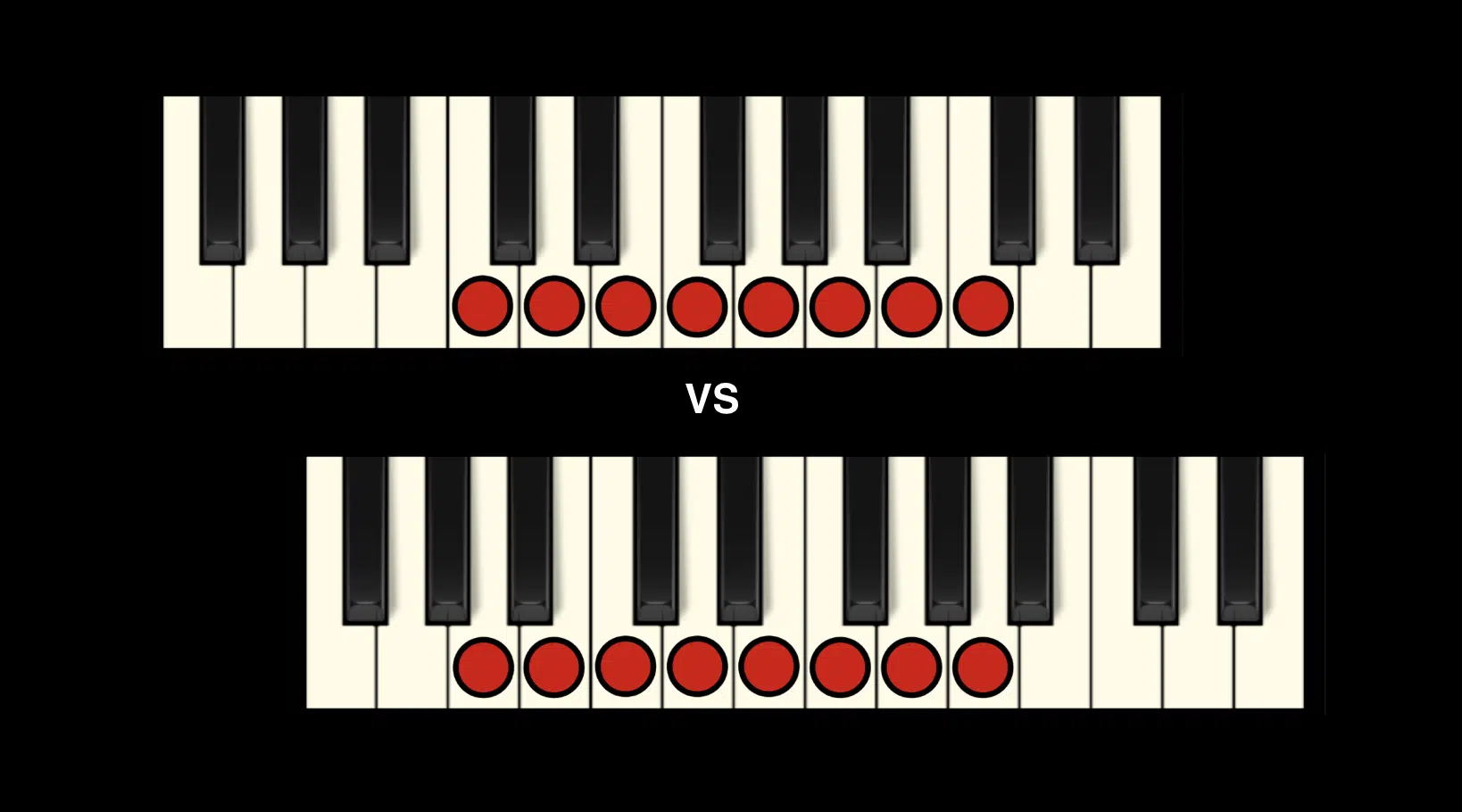
Understanding the differences between major and minor scales is crucial for understanding not only the melodic minor but music creation in general.
- Major scales (like the C Major Scale) are typically associated with a happier, brighter sound
- Minor scales (including the melodic minor scale) convey a sadder, more somber tone.
This distinction between a major scale and a minor scale is primarily due to the different intervals used in constructing them.
The third scale degree plays a significant role in determining the scale’s major or minor quality.
In a major scale, the third is a major third above the root, while in minor scales, it’s a minor third.
This small interval difference significantly impacts the scale’s overall mood and emotional expression 一 making scale choice a critical decision in music production.
Understanding The Other 2 Minor Scales
To fully appreciate the melodic minor scale, it’s helpful to compare it with the other two other scales (minor): the natural minor and the harmonic minor. Each of these other scales contributes uniquely to music composition, offering a variety of emotional tones and textures.
-
The Natural Minor Scale

The natural minor scale, also known as the Aeolian mode, is the most basic form of the minor scales; its structure is simple and uniform.
Take the E natural minor scale (starting on the root note E-F#-G-A-B-C-D) for example, where the intervals follow a consistent pattern of whole and half steps.
The natural minor scale is characterized by a somber and introspective quality 一 making it a staple in various musical genres (like jazz).
Therefore, it’s particularly effective in setting a reflective mood.
The simplicity of this scale, such as the straightforward progression of notes in the E natural minor, makes it a fundamental tool in a producer’s arsenal.
When you play or compose using the natural minor scale, you’re tapping into a deep well of emotional expression.
For example, using the C natural minor scale (containing the notes C-D-E flat-F-G-Ab-Bb) can instantly give your track a sense of depth and introspection typical of minor tonalities and melodic minor modes.
-
The Harmonic Minor Scale

`
The harmonic minor scale, on the other hand, introduces a unique twist.
It raises the seventh degree of the natural minor scale, creating a distinctive tension and resolution effect.
In the A harmonic minor scale (A-B-C-D-E-F-G#; with A being the root), the G# acts as a leading tone to the tonic 一 adding drama and intensity.
NOTE: This raised seventh degree in scales like the A harmonic minor is particularly effective in creating a sense of urgency and expectation.
It’s a scale that finds extensive use in classical compositions but is equally at home in modern genres, providing a touch of dramatic flair.
For example, if you’re working on a piece that needs an emotional lift or a dramatic turnaround, introducing a melody or chord progression in the harmonic minor scale can be transformative.
The unique interval between the sixth and the raised seventh degree (like the F to G# in A harmonic minor) offers an intriguing harmonic color.
If you’d like to learn more about the harmonic minor scale, we’ve got you covered.
-
Pro Tip: Scale Degrees in Melodic Minor Scales
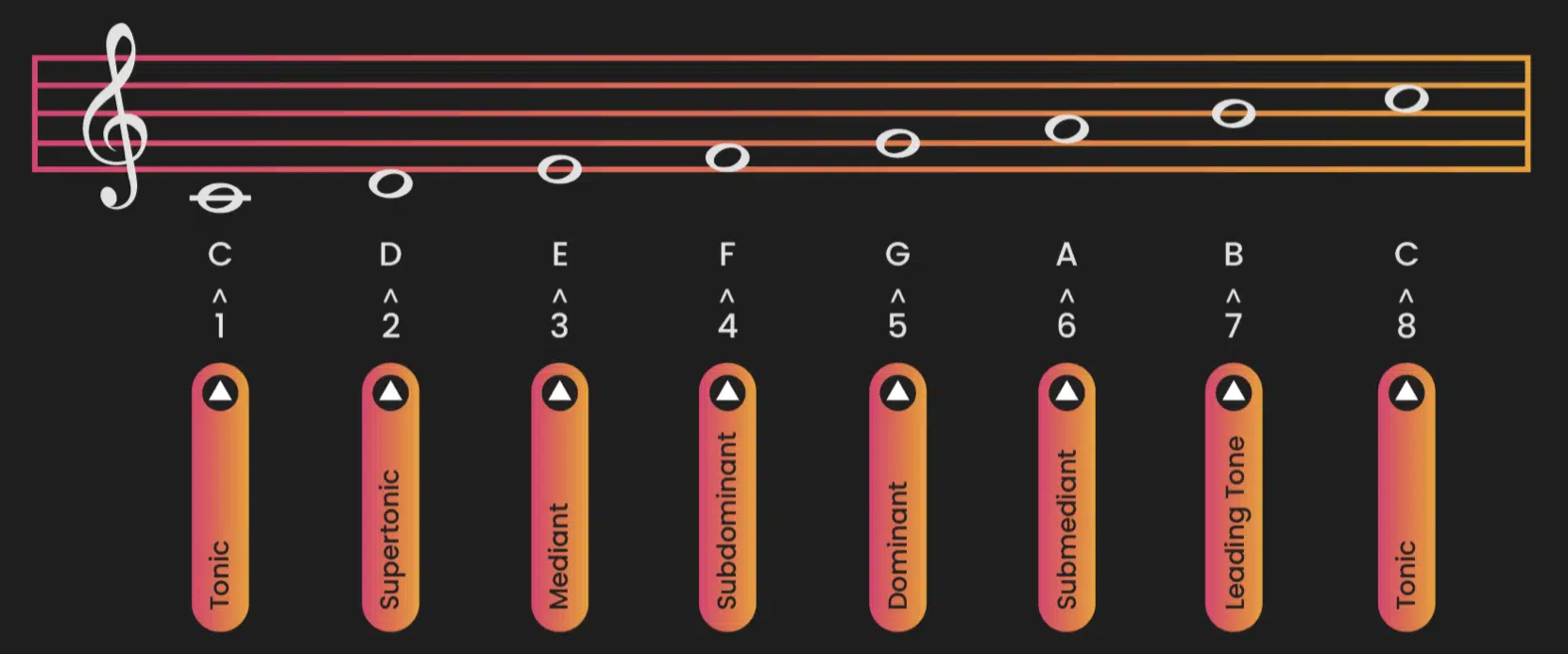
Scale degrees in the melodic minor scale (and other modes) play a crucial role in defining its character and usability in music production.
Each note in the scale holds specific importance and contributes to the overall sound and feel.
In the melodic minor scale, the altered sixth and seventh chords in the ascending form are particularly significant, such as the major sixth (F#) and major seventh (G#) in the A melodic minor scale.
These altered scale degrees provide a bridge between the minor and major tonalities.
And, in turn, this altered scale formula allows for more expressive melodic and harmonic possibilities.
For example, the major sixth (F#) in the A melodic minor scale can create a sense of brightness and lift, which is not typically found in minor scales.
Building Chords within the Melodic Minor Scale
Building chords within the melodic minor scale can help you produce sounds that blend the unique qualities of major and minor keys. This is particularly blatant in the ascending form of the scale, where the altered scale sixth and seventh scale degrees introduce an intriguing mix of tones.
-
The Ascending Form

In the ascending scale of C melodic minor (C-D-Eb-F-G-A-B), for example, the A and B (the sixth and seventh scale degrees) can be used creatively.
It can help you create chords that differ significantly from typical minor chords found in the C natural minor scale.
This technique allows you to create a sound that includes the expected minor tonalities and the unexpected major-like qualities.
It’s the key to adding depth and complexity to your tracks.
-
The Descending Form

The descending scale of the melodic minor scale, on the other hand, follows the more traditional minor scale, offering a familiar foundation for minor chords.
However, the unique sound of the melodic minor scale still shines through.
For example, using the descending scale of G melodic minor (G-F-Eb-D-C-Bb-A), the presence of Eb and F (the sixth and seventh scale degrees) can add a distinct color to the minor chords.
This is what differentiates them from those in a G major scale.
This aspect is further enhanced when considering the related modes of the melodic minor scale 一 each providing a set of unique harmonic options and textures.
Innovative Chord Progressions in Minor Keys
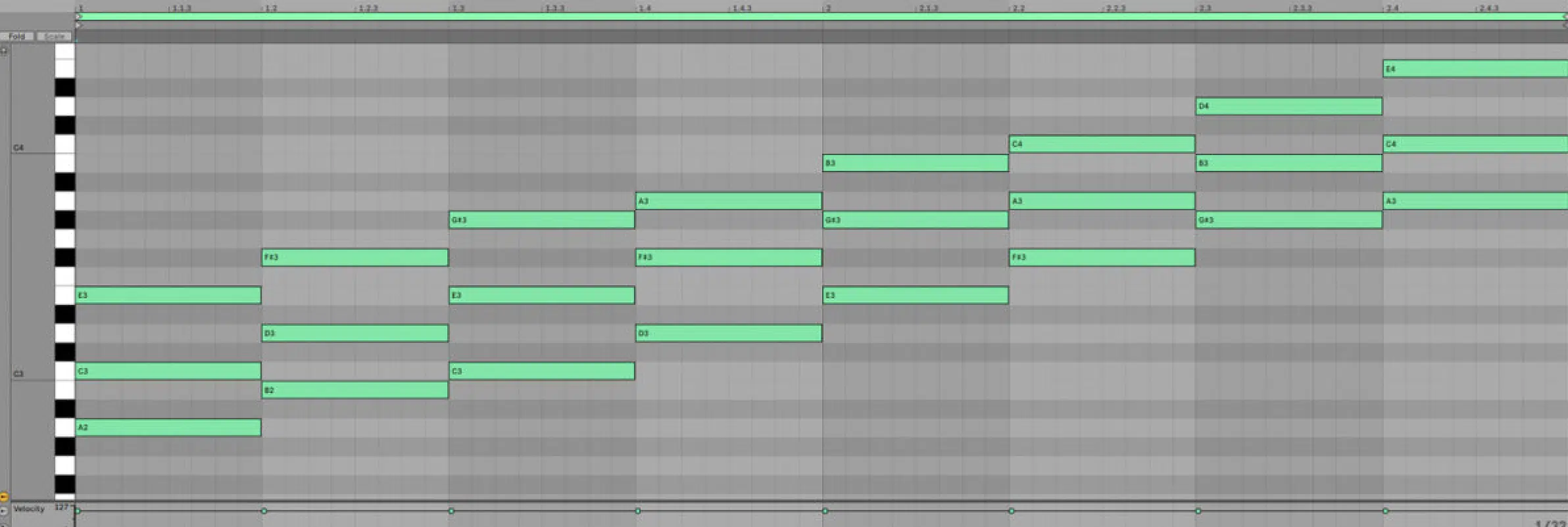
The melodic minor scale opens up avenues for innovative chord progressions in minor keys (we’re talking about minor keys right now, not major and minor keys).
By blending the ascending and descending forms of the scale, you can create progressions that are dynamic and emotionally engaging.
For example, starting a progression in the ascending A melodic minor scale and then transitioning to the descending form can create a narrative within the music itself.
Utilizing the unique intervals of the melodic minor scale, especially in the ascending form, allows for the creation of chord progressions that stand out in their:
- Complexity
- Expressiveness
- Uniqueness
This is particularly evident in genres like jazz minor scale, where the melodic minor scale’s altered scale degrees are often used to add color/depth to chord progressions.
Some examples include a chord progression that moves from an A minor chord to an F# minor chord in the context of the A melodic minor scale.
It can provide a refreshing contrast to standard minor key progressions.
The Secret To Melodic Mastery: The Unison Melodic Minor (Classical Minor) Advanced Scales MIDI Collection
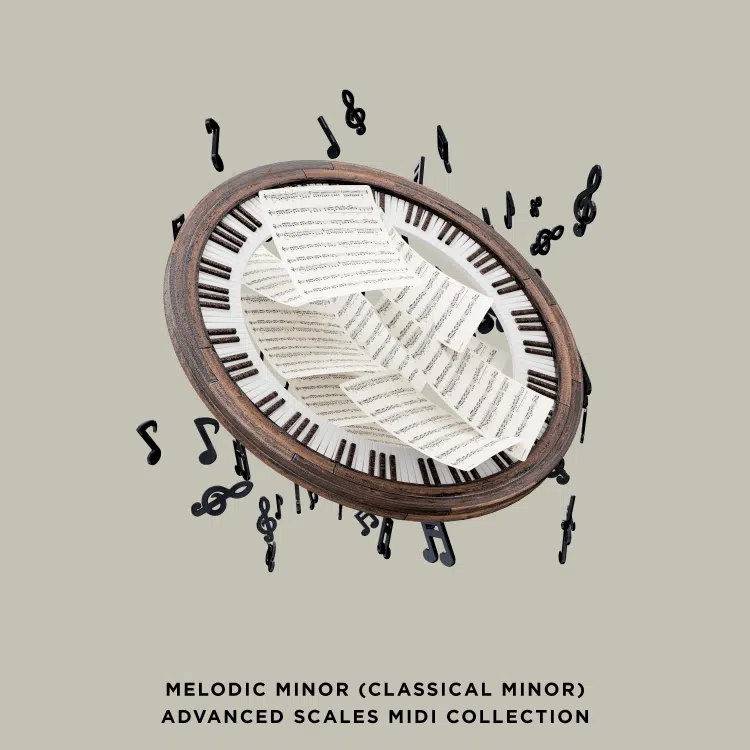
The Unison Melodic Minor (Classical Minor) Advanced Scales MIDI Collection is an invaluable tool for mastering the melodic minor scale.
This comprehensive pack is designed to instantly elevate your music production skills, providing over 1,100 mind-blowing MIDI scales, chords, progressions, and melodies.
What makes this collection remarkable is its focus on the melodic minor scale, used in timeless classics and modern productions alike.
By studying top tracks across various streaming platforms, this pack perfectly emulates the essence of what makes the melodic minor scale work in popular, unforgettable music.
The benefits of this MIDI collection are immense…
It eliminates the need to spend years mastering music theory by providing ready-to-use melodic elements and contains anything you need, like working on:
- Leads to capture your listener’s attention
- Plucks to fill out your mix
- Pads to add complexity
- Keys for structural foundation
- Arpeggios for brightening up your track
Plus, with the included MIDI files you can transpose and play around with them to fit your vision perfectly.
After integrating the Unison Melodic Minor Advanced Scales MIDI Collection into your workflow, you’ll find your music sounding more advanced and attention-grabbing.
It’s the perfect tool to make your tracks stand out 一 offering rare scales and patterns usually reserved for top-tier music producers.
Download the Unison Melodic Minor Advanced Scales MIDI Collection Now
Harmony and the Melodic Minor Scale

The harmony derived from the melodic minor scale is rich and varied, which offers a wide sound palette when played, from jazz to hip-hop and everything in between.
The ascending form of the scale, with its raised sixth and seventh degrees, introduces a harmony with a sense of tension/release that is not typically found in a standard minor scales lesson.
This can be particularly effective in:
- Creating climactic moments
- Adding depth to a track
- Capturing your listeners attention
The harmonic possibilities of the melodic minor scale are nearly endless.
From the use of extended and altered chords to the incorporation of modal interchange, the scale provides a foundation for exploring advanced harmonic concepts.
For example, the use of the Dorian #7 mode, derived from the melodic minor scale, can add an exotic flavor to your tracks.
Remember, like everything in production, the hunger to play around and experiment is key, whether it’s by a half-step, a note, or entirely different scales (like the major scale).
Yes, even if you don’t know music theory, the possibilities are endless.
-
Complex Harmonies and Melodic Minor

The melodic minor scale is ideal for creating complex harmonies and every twist and turn can be a valuable lesson (or, conversely, examples of what not to do next time).
Its unique intervallic structure allows for the formation of chords that are rich and colorful.
For example, in the A melodic minor scale, using the seventh degree (G#) in your chords can introduce an unexpected lift to a typical minor chord progression.
These complex harmonies are especially beneficial in styles like jazz and classical music, where rich and intricate chord voicings are the norm.
However, they’re also increasingly found in modern electronic music, boundaries are constantly being tested, and harmony/theory are always tested.
NOTE: Make sure to play around with the chords and voicings derived from the melodic minor scale to infuse your tracks with a level of sophistication and depth.
It will help set your tracks apart, with every note telling a story so it’s never flat or basic.
The Ascending Melodic Minor Scale & The Descending Melodic Minor Scale: Things To Remember
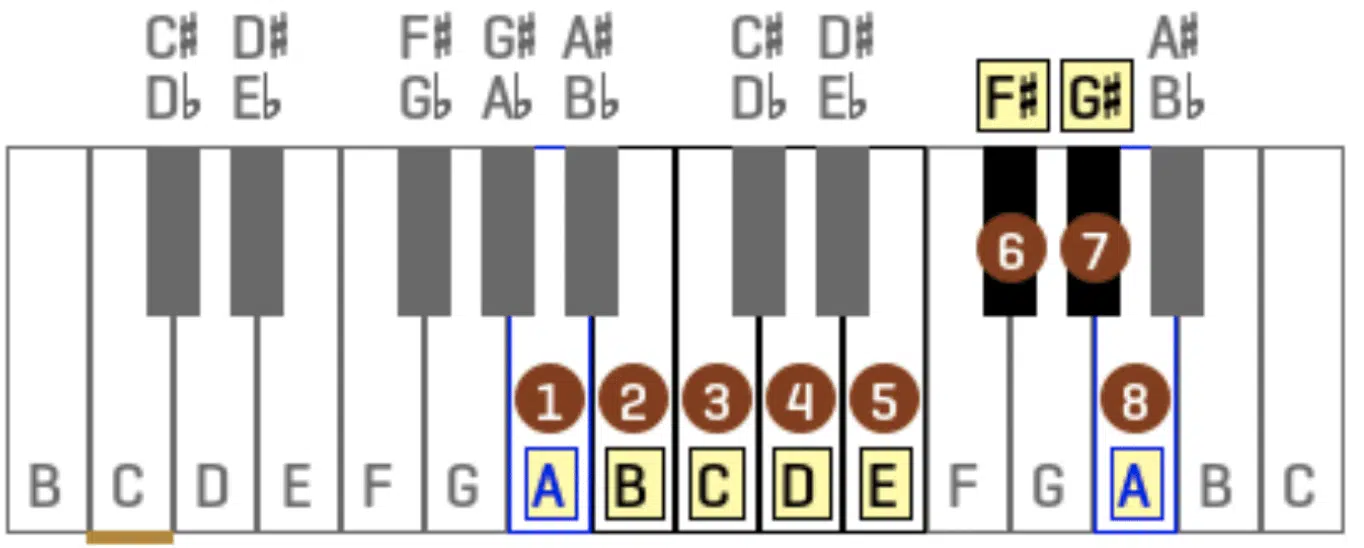
A Melodic Minor Scale
Before you go and experiment with the melodic minor scales it is important to remember some key attributes that can make the process much simpler.
The ascending melodic minor scale is particularly intriguing for its harmonic richness.
When you play an ascending A melodic minor scale, the transition from the E to F# and G# lends a hopeful and resolved feel to the music.
This unique feature can be brilliantly used to add an unexpected twist to a piece, especially in genres that thrive on harmonic complexity like jazz.
The descending form of the melodic minor scale offers a return to the familiar ground of the natural minor sound.
When descending, the scale abandons the raised notes of its ascending counterpart 一 returning to the pure minor quality.
For example, in the A melodic minor scale, descending from A to G to F and further down, reinstates the traditional minor feel.
It’s ideal for moments when you wish to reintroduce a somber or reflective mood.
This aspect of the melodic minor scale is particularly key in popular music production for creating a sense of closure or emotional depth.
The most important thing to remember, however, is that playing around is key!
Melodic Minor Scale Summary: Final Thoughts
The melodic minor scale, with its unique blend of tonal qualities, stands as an invaluable asset for creating captivating music.
Now you know its structure, the distinctive qualities of its ascending and descending forms, and how these attributes can be creatively applied in music production.
From crafting rich, complex chords to exploring innovative soundscapes through advanced scale combinations, the melodic minor scale can enhance your music.
It’s this versatility and the depth of emotion it can inject into a song that makes it a favored choice among producers across various genres.
Whether you’re playing with the chords within the scale, experimenting with its related modes, or first starting your music-making journey, this scale is super beneficial.
Remember, the goal is to harness its full potential so you can create musical narratives that make an impact and leave an unforgettable impression.
So, always keep the melodic minor scale in your toolkit and watch your tracks transform.
Until next time…
Download the #1 Melodic Minor MIDI Collection Now







Leave a Reply
You must belogged in to post a comment.